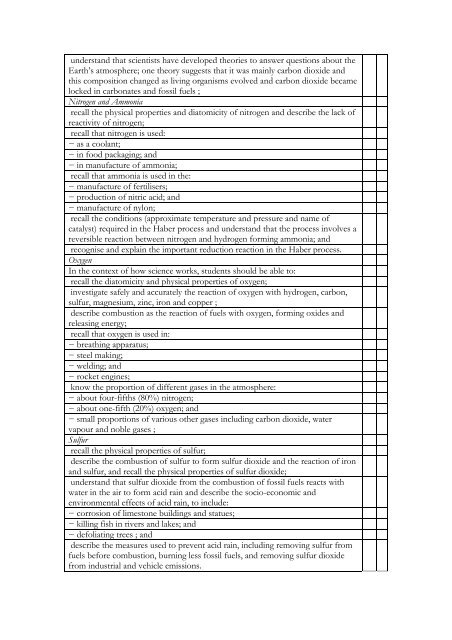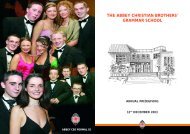GCSE Revision Advice - The Abbey Christian Brothers' Grammar ...
GCSE Revision Advice - The Abbey Christian Brothers' Grammar ...
GCSE Revision Advice - The Abbey Christian Brothers' Grammar ...
Create successful ePaper yourself
Turn your PDF publications into a flip-book with our unique Google optimized e-Paper software.
understand that scientists have developed theories to answer questions about theEarth’s atmosphere; one theory suggests that it was mainly carbon dioxide andthis composition changed as living organisms evolved and carbon dioxide becamelocked in carbonates and fossil fuels ;Nitrogen and Ammoniarecall the physical properties and diatomicity of nitrogen and describe the lack ofreactivity of nitrogen;recall that nitrogen is used:− as a coolant;− in food packaging; and− in manufacture of ammonia;recall that ammonia is used in the:− manufacture of fertilisers;− production of nitric acid; and− manufacture of nylon;recall the conditions (approximate temperature and pressure and name ofcatalyst) required in the Haber process and understand that the process involves areversible reaction between nitrogen and hydrogen forming ammonia; andrecognise and explain the important reduction reaction in the Haber process.OxygenIn the context of how science works, students should be able to:recall the diatomicity and physical properties of oxygen;investigate safely and accurately the reaction of oxygen with hydrogen, carbon,sulfur, magnesium, zinc, iron and copper ;describe combustion as the reaction of fuels with oxygen, forming oxides andreleasing energy;recall that oxygen is used in:− breathing apparatus;− steel making;− welding; and− rocket engines;know the proportion of different gases in the atmosphere:− about four-fifths (80%) nitrogen;− about one-fifth (20%) oxygen; and− small proportions of various other gases including carbon dioxide, watervapour and noble gases ;Sulfurrecall the physical properties of sulfur;describe the combustion of sulfur to form sulfur dioxide and the reaction of ironand sulfur, and recall the physical properties of sulfur dioxide;understand that sulfur dioxide from the combustion of fossil fuels reacts withwater in the air to form acid rain and describe the socio-economic andenvironmental effects of acid rain, to include:− corrosion of limestone buildings and statues;− killing fish in rivers and lakes; and− defoliating trees ; anddescribe the measures used to prevent acid rain, including removing sulfur fromfuels before combustion, burning less fossil fuels, and removing sulfur dioxidefrom industrial and vehicle emissions.
















